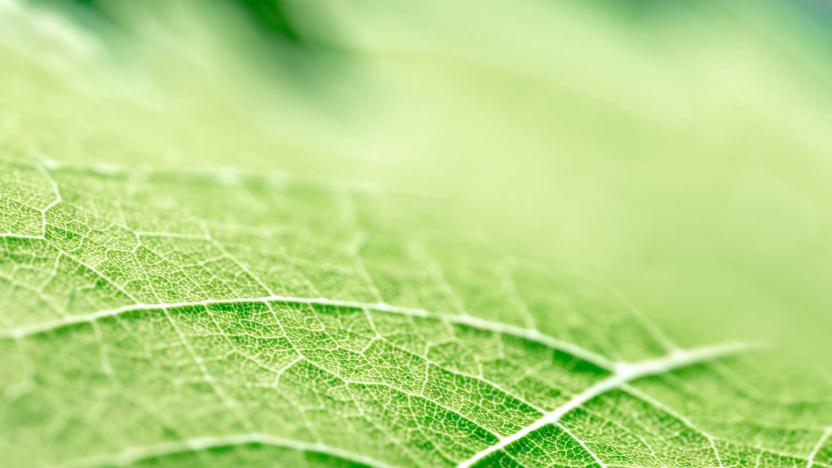vein
Latest

Leaf veins may lead to longer battery life
There have been many, many discoveries that promise longer battery life, but one of the latest is rare in taking its inspiration from one of the most common structures in nature: the leaf vein. Scientists have crafted a porous material that mimics the highly optimized flow of nutrients in plant leaves. The team used an evaporation-based process to arrange zinc oxide nanoparticles into networks with pores of various sizes that behave like you'd expect in a leaf, maximizing the transfer of material while minimizing the necessary energy.

Self-assembling material could produce artificial veins
Most attempts at creating artificial veins don't come close to replicating organic processes, but researchers at the Queen Mary University of London might change that. They've developed a technique that makes proteins and peptides self-assemble into tubular shapes that could stand in as arteries, veins and similar structures. There's no 3D printing or moulds involved -- you only need to guide the material as it builds itself. It can even grow and heal, so you're not stuck if it needs improvements.

Sony patents vein reading system for accessible computers, toilets
In a sign of just how backed up our patent system is, Sony was finally awarded a series of claims for a vein-reading mouse it filed back in January of 2009. The idea is to use an image of the blood vessels in your index finger as an authentication system. But, instead of unlocking a PC, the identity would be associated with a set of preferences -- automatically boosting contrast and text size on a screen for the elderly. While the patented claims apply exclusively to computer mice, Sony envisions vein readers everywhere, personalizing and simplifying life for the aging... even in the bathroom. Another embodiment of the system involves scanning a persons finger as they turn the doorknob to the lavatory. Once authenticated, data is sent to the toilet which automatically lifts the seat, then adjusts the force and angle of the bidet based on your preferences. Once again, Japan proves why it's winning the race in toilet technology.

Researchers use 3D printer, sugar, to create a fake artery network for lab-grown tissue
Printing a chocolate heart is easy enough, but how about an actual organ? There are folks working on it, but it turns out those veins of yours aren't exactly a breeze to replicate. Researchers at the University of Pennsylvania and MIT may have found a semi-sweet solution -- dissolving a sugar lattice in a batch of living Jell-O. The research team uses a RepRap 3D printer and a custom extruder head to print a filament network composed of sucrose, glucose and dextran which is later encased in a bio-gel containing living cells. Once the confectionery paths are dissolved, they leave a network of artery-like channels in their void. Tissue living in the gel can then receive oxygen and nutrients through the hollow pipes. The research has been promising so far, and has increased the number of functional liver cells the team has been able to maintain in artificial tissues. These results suggest the technique could have future research possibilities in developing lab-grown organs. MIT Professor Sangeeta Bhatia, who helped conduct the effort, hopes to push the group's work further. "More work will be needed to learn how to directly connect these types of vascular networks to natural blood vessels while at the same time investigating fundamental interactions between the liver cells and the patterned vasculature. It's an exciting future ahead." Scientists at other labs could also get their mitts on the sweet templates since they're stable enough to endure shipping. Head past the break for a video of the innard infrastructure.

Hitachi builds 3mm-thick vein scanner in its Transylvanian lair
Hitachi has always been hot for vein authentication modules, and its latest iteration takes the whole tech down to just three millimeters in thickness. Given that the current generation requires 23.5mm (nearly an inch) of space to operate in, it's easy to see why your netbook doesn't have one, but Hitachi hopes that's all about to change. Using a CMOS sensor to take almost instant readings, the vein scanner is deadly accurate -- there's only a one in a million chance of it authorizing the wrong person. Volume production is expected within two years, meaning that by 2011 you'll finally have a reliable way to keep your parents out of your "Misc" data folders.

Fujitsu PalmSecure mouse: reads veins, won't secure palms
If you think about all the crap you could integrate into a mouse, a world's first vein reader seems downright, ingenious. Still, it's just the latest biometric technique to join iris-scanning and fingerprint reading mousers. The USB mouse from Fujitsu incorporates their PalmSecure scanner and Windows compatible software to authenticate your veins at login. You too, assuming that hand is still attached to the rest of your body. [Via Impress]


